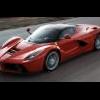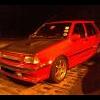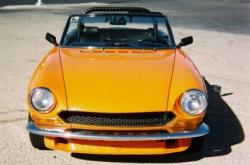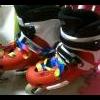Search the Community
Showing results for tags 'history'.
-
Watched this week's episode where Ceasar laid a siege on Alesia and he himself also kenna sieged. Quite nice except I got a main gripe. How come all the warriors including Ceasar machiam fight like they have watched 300? Wah lau! Two gladius wielding Ceasar, chop head off, chop arm off etc. Zhun bo? Where got fight until so luan? Roman army last time fight very discipline.
-
Just as US auto industry goes from bad to worst and even biting the dust, their counterparts in China are heading into the future (at Warp-speed!).. Today, history has been made as Chinese car-maker,BYD, begins to sell China's first hybrid car and world's 1st mass-produced PHEV, the F3DM. Note that the F3DM has beaten Toyota and GM in the plug-in area, as the two companies only plan to launch hybrid cars that can be charged from home in 2009 and 2010 respectively. IMHO, what we are seeing now is a rapid titanic shift of automotive industry in terms of innovation, competitveness and capital power. Imagine, US's richest man investing and having a stake in a Chinese auto company that has never sell cars in US itself. That, by itself, speaks volume about China's potent potential in the automotive industry. Dec. 15 (Bloomberg) -- BYD Co., the Chinese automaker backed by Warren Buffett, started selling the world
-
The following is a little history of the Toyota Starlet Turbo line of cars from 1987 - 1998. Toyota Starlet Glanza V 1996 - 1998? (EP91) Auto everything, ABS, Airbag, Climate control, lumbar adjustable driver's seat. Uses 4E-FTE 1331cc DOHC 4cyl EFI-16-valve intercooled turbo engine. Puts out 100kW@6400rpm, 157Nm@4800rpm. Weight 920kg. Toyota Starlet GT 1994 - 1995 (EP82 + Facelift) 4E-FTE 1.3l DOHC 4cyl EFI 16-valve engine. Weight around 860kg? Around this time a lot of car makers went to using round headlights. Toyota Starlet GT 1993 - 1994 (EP82) 4E-FTE 1.3l DOHC 4cyl EFI 16-valve engine. Weight around 860kg? Toyota Starlet GT 1992 - 1993 (EP82) 4E-FTE 1.3l DOHC 4cyl EFI 16-valve engine. Puts out 100kW@6400rpm, 157Nm@4800rpm. Weight 860kg. Probably the most common GT Starlet in NZ. Climate control first available in this model. Toyota Starlet GT 1990 - 1991 (EP82) 14x6 steel wheels Uses 4E-FTE 1331cc DOHC 4cyl EFI-16-valve intercooled turbo engine. Weight 830kg. Has cheap vinyl headlining (improved 1992 onwards). Air-con (Climate control 1992 onwards) Toyota Starlet Turbo S 1987 - 1990 (EP71) 14x6 Uses the 2T-TELU 1295cc SOHC 4cyl EFI 12-valve intercooled turbo engine. Puts out 82.5kW@6000rpm, 150Nm@3600rpm. Weight 790kg. hope tis helps... cheers.
-
Dear ALL, I would appreciate if some 'lau chio" "old bird" can provide us with the history of my car forum history how it was conceive .... "baby born" who are involved ..... ie 'papa & mama" website maintenance ..... cost, maintenance, moderators , who is paying for the maintenance role of mcf ..... ie what is mcf expected to be in the near future ..... who own my car forum
-
a tribute to our bro Fiat124sport here: a budget Ferrari back then....... Enjoy! Check out oso this webby for the specs: http://www.geocities.com/z-car/fiat/fiat2.html European Dual Weber Engine (Stock Specs): a) Dual 40 IDF 13/14 Webers b) 1608 cc (80 x 80 mm bore and stroke) c) 9.8:1 Compression Ratio d) 110 max HP (DIN) @ 6400 rpm e) 101 lb-ft torque (DIN) @ 3800 rpm
-
History of the Swift by Rory Daley In 1985 the Suzuki Swift was born, sort of. In its model run from 85-89 it was called the Forza and the GTI model came with the 1300cc Twin cam engine. North America received the car know as the Chevy Sprint with Suzuki's kei car engine, a 3-cylinder turbo charged unit. In 1988 Suzuki unleashed the Swift GTi on the world. Unfortunately, they sold the body style to GM's Geo division creating it's physical counterpart the Geo Metro. In the United States the Geo Metro came with the two base Swift engines; 3-cyl/no turbo, 1liter 4-cyl, but Suzuki had good enough sense to keep the 1.3 liter SOHC/DOHC units exclusive to the Swift line up. The Canadians got the Kei car motor and the name Firefly. In this world where image is everything sharing its appearance with an 'economy car' didn't exactly boost the sales of the Swift even though it was one of the better cars of the hot-hatch genre. Its main American rivals the Honda Civic, and Toyota FX-16 had no such stigma attached to them and sold in much larger quanties. To Suzuki this didn't really matter as they were selling as many rebadged Swifts as they could make to GM. Overseas the Swift was judged on its own merits as there was no Metro to cast a shadow, and when compared to the main competion it held its own: GTI-100hp from 1300cc, Civic Si-108hp from 1600cc, FX16-115 from 1600cc, Golf-115 frm 2000cc. It also came with four wheel disc brakes, something unheard of for a small 'hot-hatch' in its time. 1992 brought a small, but welcome visual change on the car. This along with an expansion in the colors in which is was offered added to an already vicious little car. But '92 also brought a fall in the hot-hatch genre in the United States, and most manufacturers either dropped their 'hot-hatches' or moved upscale. The FX16, Omni to name a few disappeared from the American landscape, while Honda and Volkwagen moved up the automotive ladder. The days of the Swift became numbered and in 1994 this performance bargain disappeared from American shores. This is where it gets interesting. The Cultus as it is known in Japan is doing quite well, as matter of fact that old droptop Geo Metro can be purchased with the DOHC 16v engine. In 1995 the Suzuki Baleno was introduced not as a replacement, as it was supposed to be, but a model to be sold side by side. Nissan did this with their 200SX. Other home market variations exist such as the all wheel drive model.
-
The first SKODA was a bicycle..Read how the humble start of the Brand Skoda. http://www.skoda-auto.com/global/100/history/1895.htm
-
The world has taken on a different shape with the birth of Formula One more than 50 years ago. Races were exclusive either to the world
-
Autodelta - a history On March 5 1963, a collective enterprise named Auto-Delta was set up by partners Carlo Chiti and Lodovico Chizzola and registered at the Udine Chamber of Commerce. Chiti had gained his experience with Ferrari, while Chizzola was an Alfa Romeo dealer from Udine. Auto-Delta became Autodelta S.p.A. in November 1964 with the self-avowed aim of helping Alfa Romeo return to racing after the company's disappearance from motorsport at the beginning of the Fifties. Autodelta was set up in Feletto Umberto (Udine) because Chizzola's Alfa Romeo dealership was located in this town in Friuli. This was the setting for the first TZ (Tubolare Zagato) cars with truncated rear ends to help them slice more smoothly through the air. The Giulia TZ, designed in 1959 to replace the Giulietta SZ, was introduced in June 1962. At least 100 cars had to be built to qualify for Gran Turismo homologation. A total of 124 were built. The engine was a 112 bhp 1.6 unit. The car's dry weight was just 660 kg. Its top speed was 215 km/h. The car made its racing debut in Monza in November 1963 at the Coppa Fisa, when four Alfa Romeo Giulia TZ cars took the first four places in the prototypes category, driven by Lorenzo Bandini, Roberto Bussinello, Giancarlo Baghetti and Consalvo Sanesi. The car was homologated in the Gran Turismo category at the beginning of 1964 and scored a success in its category in the Sebring 24 hour race in Florida (the following year, it drove off with the first three places in its category) with Stoddard-Kaser, followed by more success, again in Gran Turismo up to 1600 cc, at the 48th Targa Florio with Bussinello-Todaro, third place overall in the 1000 kilometre Nurburgring race with Biscaldi-Furtmayr and at the Le Mans 24 Hour race with Bussinello-Deserti. The Giulia TZ was also successful in rallies: the French team Rolland-Augias did well overall in the Coupe des Alpes and Criterium des Cevennes and came second overall in the Tour de Corse and first in its category at the Tour de France. The Alfa Romeo Giulia Ti Super (Jolly Club) immediately revealed itself as a force to be reckoned with in rallies: De Adamich-Scarambone were successful in the Rally dei Fiori, with Cavallari-Munari at the first edition of the legendary S. Martino di Castrozza event. At the end of the year, Autodelta was transferred from Feletto Umberto (Udine) to Settimo Milanese to enable the company to work more closely with Alfa Romeo. In the meantime, the Balocco site had been set up as a test track for all racing cars and other vehicles. Balocco was the place where the bends and straights of the most important racing circuits in the world were prepared (most importantly the bends at Lesmo, sections of the circuits at Zolder, Zandvort, le Mans, etc). The area that has remained unchanged since the time when prototypes and standard production cars were tested still retains the name of 'Alfa Romeo mixed'. You can still see the original Bella Luigina Farmstead and adjacent Autodelta workshop where racing versions of Alfa Romeos were taken for inspection. The lap time recording booth can still be seen on the track. 1965 was another bumper year and culminated in outright wins by the Giulia TZ at the Melbourne 6 Hour race with Roberto Bussinello and at the Giro d'Italia with Andrea De Adamich and Franco Lini. The same year, the Alfa Romeo Giulia GTA was introduced at the Amsterdam Motor Show and then at the Geneva Motor Show. This was a converted, mainly racing version of the Alfa Romeo Giulia GT launched two years earlier. The letter A stands for alleggerita (lightened) because 205 kg was shaved off the weight of the standard production model through the use of light alloy outer panels fully riveted to the structure (without antinoise panels). The racing version weighed just 700 kg. It differs from the normal model in its twin ignition cylinder head (two spark plugs per cylinder). The car delivers a power output of 115 bhp at 6000 rpm for a top speed of more than 185 km/h on the road version that increases to 220 km/h for the racing version due to its higher power output of 170 bhp at 7500 rpm. This 1600 cc model won the European Makes Challenge for three years running, from 1966 to 1968, and the Drivers' Challenge with Andrea De Adamich (1966 and 1967) and with Spartaco Dini (1968). Ignazio Giunti won the European Mountain championship in 1967. The GTA won innumerable successes during this three-year period, including wins abroad, in the US and in South America. The GTA's most prestigious accolades included 1st, 2nd and 4th places overall at the Nurburgring Six Hour race in 1967, and 1st and 2nd places overall in the Castle Rock-Colorado 250 Mile race. In 1966, the Giulia GTA won a major rally title: Arnaldo Cavallari and Dante Salvay went home with the Mitropa Cup. Again in 1966, Autodelta became an associate company of Alfa Romeo and Carlo Chiti became its director. From then on, Autodelta became Alfa Romeo's competitive wing for racing and the development of new technologies. In 1967, a turbocharged GTA prototype was built to compete in Group 5 races. The engine, developed by Autodelta, combined two coaxial centrifugal compressors, each with one oil-driven turbine pressurised by an axial pump connected to the engine by a chain. One other distinctive feature of the engine was the fact that it was water-cooled directly into the fuel ports to reduce the temperature of the mixture in the combustion chamber. The car's power output was 220 bhp and during tests at Balocco, this GTA identified by the initials SA (sovraalimentata - supercharged) exceeded 240 km/h. The car won the Hockenheim 100 mile race driven by the German driver Dau. A 1300 cc aspirated version of the car was produced in 1968 to meet the needs of private drivers. The car, known as the GTA 1300 Junior Autodelta, was a no-holds-barred racing car that dominated its cylinder category for four years. Due to a specific points award system, the model succeeded in winning the outright European title in 1971 and 1972. The production run of the GTA 1300 Junior ran to 447 units. Racing versions prepared by Autodelta delivered a power output of 160 bhp at 8000 rpm. In 1970, the Dutchman Toine Hezemans won the title in an Alfa 1750 GT Am (Am stands for America), derived from the American version of the GT 1750 with Spica injection. The body came with broader wings to accommodate 13 inch wheels with a size 9 front channel and rear channel of up to 11. This car took on opposition such as BMW and Ford with significantly higher capacities but often managed to overcome its disadvantage to take the lead. The following year saw the arrival of the 2000 GT Am, a leading light in all races and often an outright winner. In 1970, the car surprised everyone to take the title at the Spa Francorchamps 24 Hour race, when it also won the Coupe du Roi for the best team. It went on to repeat its success for seven consecutive years to 1976. Some 40 units of the GT Am were built. SPORTS PROTOTYPES Autodelta also built cars for the Sport Prototype category as well as for the Touring category. Its first designs date back to 1964 and the first car was built in 1965. The first prototype was built at Alfa Romeo and then sent to Autodelta for development and additional changes required by the manufacturer. The car was fitted with the TZ2's four cylinder engine. This was a major step for Autodelta that went on to develop a 1998 cc V8 engine. This was the first Alfa Romeo to be fitted with a rear engine integral with the gearbox and jointed rear axle. The chassis was inspired by aeronautical engineering and consisted of three aluminium pipes measuring 200 mm in diameter in the shape of an asymmetrical H designed to contain a rubber fuel tank. The result was the 33/2, a car that weighed just 580 kg and packed a power output of 270 bhp that propelled the long-reared version to a speed of 298 km/h. The car made its debut on 12 March 1967 and went on to win the Fl
-
Sebastien Loeb
-
An interesting article about the legendary Skyline Full article available at http://www.autotrade.com.my/emzine/review/...d=RT.ATC.CAR.FS ======= The Skyline is a respected model in Japan because it has quite a long history. The first generation was built in 1955 by the Prince Motor Company. At that time, Prince Motor was an independent automaker, having evolved from the Tama Electric Car Company which had been formed by the Tachikawa Aircraft Company. Prince Motor was merged with Nissan in 1966 when the Japanese government urged the larger car manufacturers to take on the smaller ones in order to make the motor industry stronger and more competitive. However, given the fame of Prince Motor and its Skyline, the company still has a
-
Anyone out there (esp Skoda owners, fellow VAG-ers', etc.) ever wondered what on earth the Skoda emblem really was ? Well, sadly, I occasionally did and actually had some digging done and, well, here's what got unearthed..... Can't help but wonder what happened between 1937 and 1991, tho'..... No idea why the pics got all jumbled-up - posted them in sequence....
-
To celebrate our little..er...joy....thought I'd post a little article on the history of Seat which I.....er.....borrowed from the Seat forum. Enjoy! For the first 33 years of its existence, the Sociedad Esp
-
http://www.geocities.com/ruuds70/850.html

















